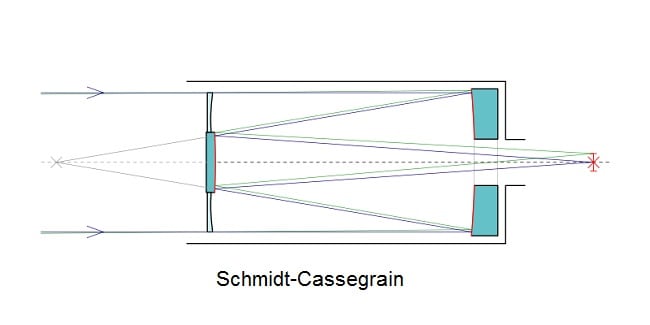Choosing a telescope to buy is always a daunting task, especially with all the different varieties and technical terms that you must first understand. Before making an informed decision, and what makes it even worse, is that the packaging on telescopes can often be misleading and cause more confusion for first-time buyers and even remorse.
A compound telescope also called Catadioptric. Specifically, Schmidt-Cassegrains, or Maksutov-Cassegrains are telescopes made of refractor, and reflector style construction. The term “compound” comes from the 2 styles used together.
Also, another reason is that; light is being focused back and forth on two or more elements meaning refractive lenses and reflective mirrors. This build on one another, or “compound effect” gives way to a short tube with a longer focal length. Think like a compound bow used in hunting.
Is it any better? That is based on opinion, but for a compact design with quality views it is considered better. However, the price tag is higher than that of a typical telescope. Let’s dig a little deeper!
A Little More Detail On The types
There are three basic types of telescopes which differ on how each processes the light that comes through their scope:
- Refractor telescopes – this type of telescope is probably the most familiar for non-astronomers. This is the first type of telescope that was invented and is the simplest in terms of construction, with its use of a lens to gather and focus light.
Because of this, they require less maintenance than the other two types of telescopes and are therefore more popular with beginners. They have an excellent performance and are relatively insensitive to light pollution. However, they are also the most expensive.
- Reflector telescopes – this type of telescope uses a mirror to gather and focus light rather than a lens. Because of this, they have the advantage of being cheaper compared to a refractor telescope with the same aperture.
The most common reflector telescope is the Newtonian reflector.
- Compound telescopes – this type of telescope is the most modern of the three and is made as a combination of both refractor and reflector telescopes. They use both lenses and mirrors to gather and focus light. The two most popular compound telescopes are the Schmidt-Cassegrains and Maksutov-Cassegrain telescopes.
This allows them to have a long focal length with a short tube, a compact stable design.
With its compact construction, compound telescopes can be made more compact compared to the other two types of telescopes. Because of this, they can be used with lighter and more economical mounts than is required for the different two types. This also provides the advantages of both refractor and reflector telescopes which makes it an excellent all-purpose telescope.
What is a Schmidt-Cassegrain Telescope?
Schmidt Cassegrain telescopes are one of the most popular types of telescopes because of its versatility and compactness of the optical design. They can be easily recognized for their short tube length. It uses a primary mirror with a central hole which throws back the incoming light to focus it on a secondary mirror. The light is then reflected again to pass the central hole of the primary mirror into the focuser at the back of the telescope.
The convex curvature of the secondary mirror allows the Schmidt Cassegrain telescope to have focal lengths of about 5 times longer than the tube length. To illustrate this, we can take a look at an example of an 8″ telescope.
The primary mirror of this telescope would have a focal length of about 16″, which means that it focuses the light it receives to the point that is 16″ in front of the mirror. The convex secondary mirror is then placed between the primary mirror and its focal point, reflecting the light back to the primary mirror but at a less steep angle.
Most secondary mirrors used for Schmidt Cassegrain telescopes can provide up to a 5x magnification factor. In this example, such a secondary mirror would make the effective focal length 80”.
What is a Maksutov-Cassegrain Telescope?
Maksutov-Cassegrain telescopes work in the same way as a Schmidt-Cassegrain telescope, having a spherical primary mirror and a secondary mirror. The only difference is that the Maksutov-Cassegrain telescope has a meniscus-shaped lens at the front aperture and has no Schmidt plate.
The secondary mirror of the system also has a metal coating vapor-deposited onto the back of the meniscus lens. This allows the system only to have a small amount of chromatic aberration while even correcting the spherical aberration produced by the primary mirror.
What are the Advantages and Disadvantages of Compound Telescopes?
Advantages: Compound telescopes have the advantage of having a long focal length even with their short tubes. This makes these telescopes perfect for observing planets and the moon because of the higher magnification that it can achieve.
Having a short tube also means that even with big apertures, it still weighs much less than the equivalent of the same aperture of reflector or refractor. It also makes them very portable and very easy to assemble and disassemble for viewing.
Disadvantages: However, both of these telescope styles have the problem of not being as good for deep sky objects like galaxies and planetary nebulas because of its high focal ratio and narrower field of view. Do not get me wrong here though, it can find a nebula with wide field of view eyepiece.
Because of the focal length you can use a bigger eyepiece and get the same magnification. May be a plus for those with corrective wear? Check out this article Can I Wear Glasses or Corrective Wear Using My Telescope
Advantages of Schmidt-Cassegrain Telescope
Because the corrector plate of the Schmidt-Cassegrain telescope is an aspheric lens, it allows having big apertures because the lens plate is thin and easier to manufacture. This also adds another advantage of requiring lesser time for the whole telescope to thermally equalize to the outside temperature on your viewing site.
Its secondary mirror, on the other hand, allows this telescope to be free of diffraction spikes. Another advantage of this telescope is with its collimation. Its collimation tends to be solid, which means it does not require repeated collimation often at all, or throughout the night.
Advantages of Maksutov-Cassegrain Telescope
For the Maksutov-Cassegrain telescope, it has a highly curved spherical lens (called the Maksutov corrector plate), which allows an improvement on the amount of chromatic and spherical aberration. This is usually made much thicker than the correctors used on Schmidt-Cassegrain telescopes, and because of this, the size of the apertures available for Maksutov-Cassegrain telescopes are generally smaller.
Another advantage is that its secondary mirror is smaller than those in on Schmidt-Cassegrain telescopes, so there is less obstruction in the light path. This results in a sharper and brighter view or image. You get a substantial focal length over the Schmidt as well especially compared to the same diameter tube version.
What is a Compound (Schmidt Cassegrain) Price Range
The classic Celestron 8” Schmidt Cassegrain starts at $1200 on Amazon for example. You can check it out here. But we wanted a group of sizes to cover all 3. Cassegrain, Refractor, and Reflector. The examples below in the 4” category on Celestron’s website at the time of writing this was the list price at $499 for comparison.
The Improvement Over A Refractor Telescope
Focal length and compact design for the same price range is the main advantage over a refractor of the same size. Compared to the 4” (102mm) refractor Celestron Nexstar 102SLT at the same price as a Nexstar 4SE 4” Maksutov-Cassegrain.
They both have the same max useful magnification out of the box at 241X, but the 4SE has a focal length of f/13, over the 102SLT at f/6.47. So, it depends on what you want to do really, but to see space, you will get more out of an f/13 over time I believe.
Learn More about the F Ratio with this article, What the F Ratio Means and Does in Telescope talk
The Improvement Over A Reflector Telescope
The speed of setup the main thing and also the focal ratio. Keeping with the price range of sizes above, a Newtonian style reflector Celestron Nexstar 130SLT rings in at the same price to keep it apples for apples. This scope had a max useful magnification of 307X out of the box. With an f/5 focal length. But it was 5.11” or (130mm), so you get more light into your eye.
Reflector telescopes can easily get to the focal length of the compound telescope for less money, but we wanted to keep it in the same computer-controlled scope for comparison. Also, many like going to a Dobsonian style scope with a bigger mirror in the reflector category which can be very affordable for diameter. Learn more about Dobsonians with, What is a Dobsonian Telescopes.
Can These Types of Telescopes be Used in Astrophotography?
With the compound telescopes, you will be moving the primary mirror to achieve the focus. This allows the use of any camera for prime focus astrophotography. They have a disadvantage of having a field of view more narrow because of their longer focal length.
If you need a full field of view, and an ability for deep space objects as well the narrow field can be remedied by adding some focal reducers to get a wider field of view. A good focal reducer will widen the sky for astrophotography. Here is a good one from Celestron on Amazon The Celestron EdgeHD 8″
As with all other telescopes, no matter how beautiful and expensive it is, it would still be nothing without the proper knowledge of astronomy. Knowledge will always be your best tool in this hobby as it will not only guide you on the proper techniques, but it will also give you a much grander appreciation of the hobby that you are taking part in.
Need More?
Feel free to browse this website to find more informative articles that will help you get the most out of this hobby. Here is an article you might enjoy, “The Reason Planets Appear Black and White in a Telescope”.
To see what Cassegrains I recommend, take a moment to visit my Recommended Gear Page.


